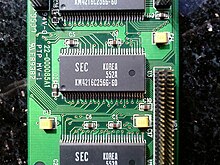This article has multiple issues. Please help improve it or discuss these issues on the talk page. (Learn how and when to remove these template messages)
|
Dual-ported video RAM (VRAM) is a dual-ported variant of dynamic RAM (DRAM), which was once commonly used to store the framebuffer in graphics adapters.
Dual-ported RAM allows the CPU to read and write data to memory as if it were a conventional DRAM chip, while adding a second port that reads out data in a serial fashion. This makes it easy to interface with a video display controller (VDC), which sends a timing signal to the memory and receives data in the correct sequence as it draws the screen. Because the CPU and VDC access the memory simultaneously on different ports, dual-ported RAM does not require the CPU to pause while the VDC uses memory, thereby eliminating the associated wait states and improving overall system performance.
Dual-ported RAM was common from the mid-1980s into the mid-1990s. After that date, new forms of high-performance memory began to be used that eventually replaced dual-ported designs. As these other forms of memory are also known as video memory, and thus VRAM, it sometimes confused with this older form of memory.
